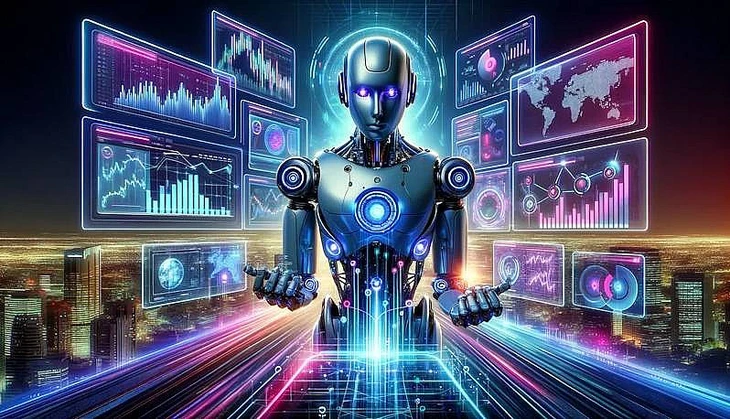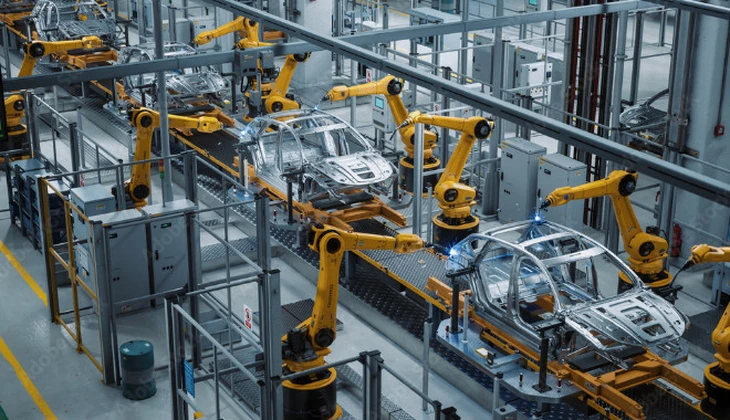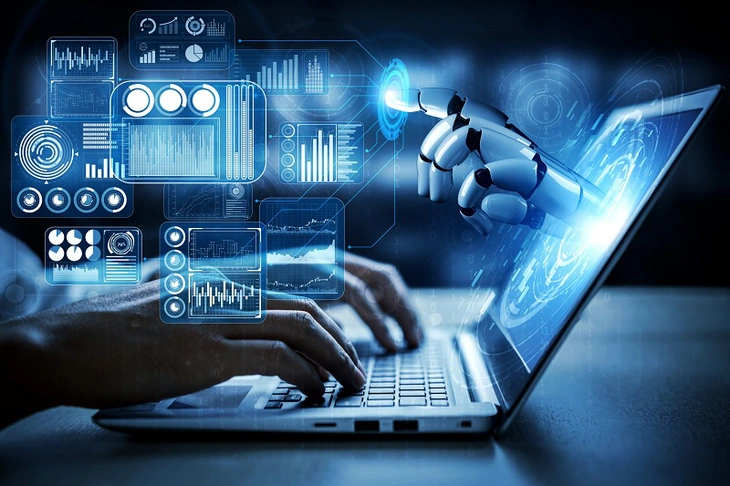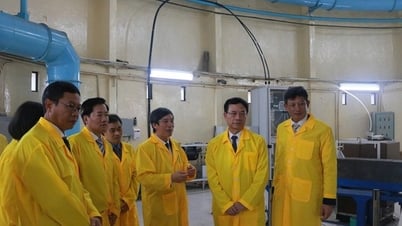
Many professions are at high risk of being completely replaced by AI in the future.
Artificial intelligence (AI) is increasingly infiltrating every corner of life, from offices to factories, from keyboards to hotlines. AI is learning to write, program, even... give legal advice.
In that context, many professions that were once "untouchable" are gradually disappearing silently, completely replaced by AI. So have you ever wondered if the job you are doing will still exist in 10 years?
Here are the Top 10 occupations at high risk of being replaced by AI in the future:
Data entry and processing staff

Data entry and data processing workers are at risk of being replaced by AI soonest.
This is the group of jobs that is at risk of being replaced by AI first because of its repetitive nature, clear processes and low need for creative thinking. Current artificial intelligence systems can automatically recognize characters (OCR), extract information from digital or scanned text, then enter it into a database with speed and accuracy far surpassing humans.
In businesses, data entry roles – typically associated with invoices, documents, and basic bookkeeping – are increasingly being replaced by integrated AI software. Platforms like UiPath, Microsoft Power Automate, and RPA (robotic process automation) tools can perform thousands of tasks without manual intervention.
With its operational efficiency and low costs, this is an area that is almost certain to be fully automated in the near future.
Basic accounting, junior auditor

Basic accounting, junior auditor
Basic accounting tasks like recording transactions, reconciling invoices, and creating financial reports are increasingly being automated thanks to AI and data processing technology. Software like QuickBooks, Xero, and Zoho Books can input data, categorize expenses, and detect financial errors in seconds.
AI can also learn from historical data to detect anomalies that humans often miss due to time constraints or subjectivity. For junior auditors, the role of checking items on a checklist can also be replaced by an automated analysis system.
While senior finance professionals still play a strategic role, much of the procedural accounting work is moving away from direct human intervention.
Basic Customer Service Representative

Basic Customer Service Representative
With the rise of chatbots and virtual assistants, many businesses have turned to AI to handle repetitive requests like information lookups, ordering, returns, or product instructions. The system can operate 24/7, respond instantly, and continuously learn from customer data.
Technologies like Google Duplex, ChatGPT API, and AI-powered customer care platforms are becoming increasingly popular, especially in e-commerce, banking, and telecommunications. They help reduce operating costs and improve user experience at a basic level.
While complex cases still require humans, most front-line customer service positions — which typically handle simple questions — are being replaced.
Junior Programmer/Repetitive Coder

Junior Programmer/Repetitive Coder
AI is now capable of automatically generating code, fixing errors, and assisting with basic software design with remarkable speed and accuracy. Tools like GitHub Copilot, GPT-4, or Replit not only help programmers increase productivity, but also gradually replace simple, repetitive programming or software testing tasks.
Tasks like writing code snippets, checking for syntax errors, or creating templated functions are being automated by AI. This could lead to the role of low-level programmers being reduced if they do not develop specialized skills and creative thinking.
AI is becoming a support tool, but also posing a challenge forcing programmers to improve their skills to avoid being replaced in the future.
Telesales staff, telephone survey

Telesales staff, telephone survey
Voice AI is taking automated calling systems to the next level. AI can now make outgoing calls, capture customer needs, respond dynamically, and capture data with a natural, nearly indistinguishable human voice.
Platforms like Replika AI, Google Duplex, or AI Call Center solutions can handle thousands of calls every day without breaks, while learning to improve communication efficiency. This is especially effective for large-scale sales campaigns or periodic surveys.
While senior telesales still requires emotional and persuasive elements, most scripted calling positions will likely soon be fully automated.
Manual labor

Manual labor
Robots and automated AI systems are increasingly replacing workers in manufacturing, packaging, and shipping lines. With the ability to operate continuously, with high precision and minimal errors, robots help factories like Tesla or Amazon warehouses increase efficiency and reduce labor costs.
Repetitive, manual or precision tasks such as assembly and sorting are increasingly being automated. This poses a major challenge to the unskilled workforce and forces businesses to retrain and reskill their workers.
Smart manufacturing technology is considered an inevitable trend, and at the same time a profound pressure to change traditional industries.
Basic photo and video editor

Basic photo and video editor
AI technologies like Runway, Canva AI or Photoshop AI are changing the way images and videos are processed. These tools can automatically edit photos, remove backgrounds, add effects or create short videos with high speed and accuracy, reducing the dependence on manual operations.
Repetitive editing tasks that do not require much creativity or original ideas such as basic cutting, color correction, and simple effects processing are gradually being replaced by AI. This reduces the demand for basic editing positions at media, marketing, and content production companies.
However, creative work that requires aesthetic thinking and unique ideas still requires human hands.
Legal assistant, contract analysis

Legal assistant, contract analysis
AI in the legal field is increasingly being used to process complex legal documents with exceptional speed and accuracy. AI systems can read and analyze thousands of pages of contracts, extract key terms and detect potential risks faster than humans.
Tasks such as contract review, repetitive legal drafting, and standard clause review are increasingly being automated, putting the role of legal assistants and entry-level contract analysts under pressure as technology advances.
However, strategic legal decisions and complex situations still require the intervention of experienced legal professionals.
Fundamental Data Analyst

Fundamental Data Analyst
AI technology, combined with data analytics platforms like Power BI or Tableau, is automating data processing and creating visual reports. AI has the ability to synthesize and analyze trends from large volumes of data faster and more accurately than humans.
Data analyst positions that focus on repetitive tasks like compiling data or creating periodic reports without strategic depth are easily replaced, while roles that require deep analysis and complex data-driven decision making still require human involvement.
AI is not only a support tool but also a big challenge that forces analysts to improve their skills and strategic thinking to maintain their position.
Bank teller, cashier

Bank teller, cashier
Many banks around the world have been promoting automation through channels such as smart ATMs, digital banking and AI assistants to support transactions. These services allow customers to perform most basic transactions such as transfers, payments or balance checks without having to go to the counter.
This has led to a significant reduction in the need for bank tellers and cashiers at traditional branches. Simple paperwork, data entry and consulting tasks are increasingly being replaced by automated systems that operate 24/7 with lower operating costs.
However, complex transactions or requests for personal advice still require the intervention of an experienced banker.
How humans can leverage AI instead of being replaced
Improve digital skills and AI literacy
In the context of rapid AI development, grasping basic knowledge about how AI works, its advantages and disadvantages, and practical applications becomes a key factor to help users maximize the benefits of the technology.
This understanding not only helps to exploit AI tools effectively but also avoids risks such as over-reliance or information manipulation.
Digital skills such as data management, evaluating AI results, and choosing the right tools are becoming the new standard in the modern workplace. This is also the first step for each individual to be able to effectively coordinate with AI, improve productivity and creativity at work.
Focus on soft skills, creative thinking and judgment
While AI is becoming increasingly intelligent, creativity, emotion, and the ability to process complex situations based on context are still uniquely human strengths. Soft skills such as communication, negotiation, conflict management, and critical thinking cannot be easily replaced.
Developing these capabilities helps workers maintain a competitive edge and collaborate effectively with AI on tasks that require flexibility and creativity. This is the key to adapting and developing sustainably in the digital age.
Use AI as an assistant, not a replacement
AI is being used to automate repetitive tasks, speed up processing, and reduce errors compared to manual work. This frees up time and brainpower for humans to focus on higher-value tasks such as strategic planning, product innovation, and customer relationship building.
Seeing AI as a supporting tool rather than a complete replacement not only helps improve work efficiency but also creates a collaborative environment between humans and machines, thereby maximizing the advantages of both.
Continuously learn and update new technology
In the context of AI technology constantly evolving, constantly updating knowledge and familiarizing with new tools is a vital factor to maintain initiative in work. Those who are flexible in learning and adapting to modern AI solutions will have a clear competitive advantage.
Rapid access to new technologies increases work efficiency and expands career opportunities, while minimizing the risk of being left behind in the digital revolution.
Human-in-the-loop
The working model combining humans and AI is becoming a trend to optimize performance. In which, AI takes on automatic tasks, processes big data quickly and accurately, while humans play the role of monitoring, making final decisions and handling complex situations.
This approach helps exploit the strengths of both sides, minimize machine errors, and take advantage of human flexibility and creativity. Effective coordination between humans and AI not only increases productivity but also improves the quality of work.
Develop AI management and control skills
AI is only truly effective when properly controlled. Mastering the input data, monitoring the processing, and evaluating the output results are important skills to ensure AI operates accurately, transparently, and in line with business goals.
There are many cases where AI produces misleading results due to biased data or lack of proper supervision. Therefore, the ability to manage AI - from understanding how it works to knowing how to adjust when necessary - is becoming an essential skill in the digital age.
The rapid development of artificial intelligence is creating profound changes in the global occupational structure. However, AI is not necessarily a threat, but can become a powerful support tool if used properly by humans.
Adapting to technology, upgrading skills, and maintaining critical and creative thinking will be key to helping workers maintain their role in the digital age.
Source: https://tuoitre.vn/10-nganh-nghe-co-nguy-co-cao-bi-ai-thay-the-hoan-toan-trong-tuong-lai-20250529110439358.htm



































































































Comment (0)